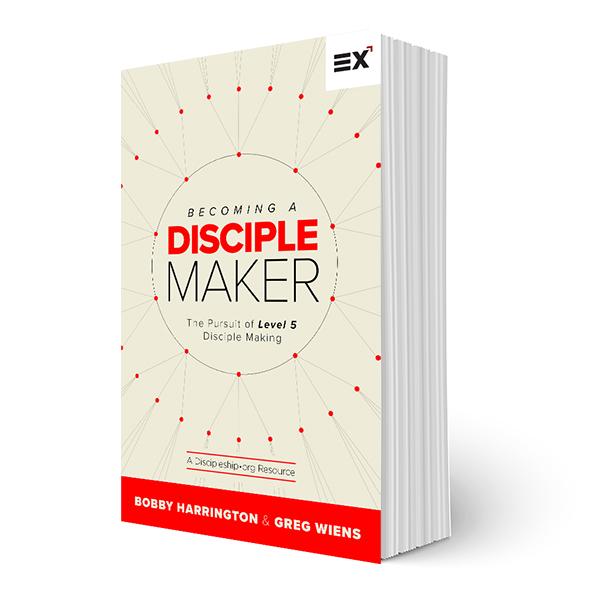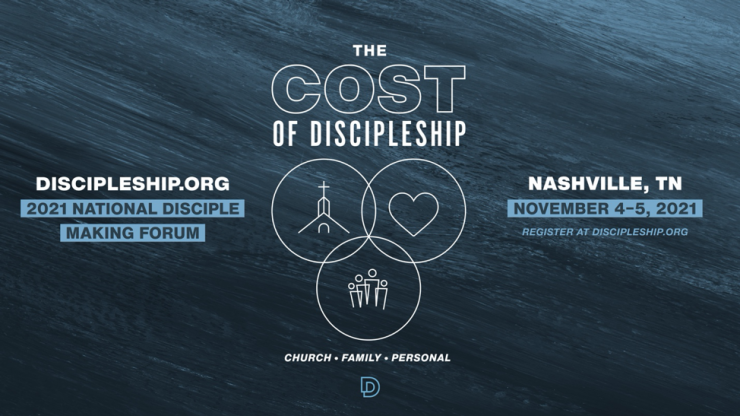Jesus the Disciple Maker
This blog is an excerpt from the free eBook, Becoming a Disciple Maker. Download it free here.

As we read the gospels, we see Jesus as the master disciple maker. He spent most of His time and the best of His time in public ministry focused on that one thing. Jesus was all about relating to individuals as people of value. He accepted them where they were, but He didn’t leave them there. He loved them in spite of their foibles and through grace guided their transformation into a God-centered life.
Peter is a prime example of this. In Matthew’s gospel, one moment we see Jesus praise Peter for identifying Him as the Messiah, and then in the next moment He accuses Peter of being an ally of the enemy (Matt. 16:16-23). In John 18, Jesus asks Peter, James, and John to pray for and with Him during one of His most difficult hours. Then a few minutes later, Jesus chastises Peter for cutting off the ear of the Roman soldier, Malchus. In the same chapter, Peter emphatically states that he would “never” leave Jesus, only to deny ever knowing Him that same night. But Jesus never gave up on him. The same man who denied His master three times in a few hours became a founding disciple maker in the Jerusalem Church.
History tells us that Thomas reproduced himself as he traveled many places and eventually gave his life for the cause, despite being a doubting personality and one who was hard to convince (John 20:27). It was Phillip who brought Jesus to frustration when he simply couldn’t figure out what Jesus was saying (John 14:9). And in John 3, Nicodemus seems to be slow in comprehending the theological concept of being born anew spiritually. Martha was consumed in the details and lost sight of the important things in life (Luke 10:38). Zacchaeus had many shady dealings in his past, but Jesus saw his potential as an influencer of others.
This is from Bobby Harrington and Greg Wien’s free eBook, Becoming a Disciple Maker. Download the eBook here in your favorite format at no cost.
Each of these men and women had their problems, and yet Jesus met them where they were and matured them into disciples, ultimately equipping them to make disciples of others. A person was never a dead end cul-de-sac of ministry for Jesus. He clearly saw their potential for personal transformation, as well as transforming others after He was gone.
Yet Jesus didn’t love these individuals just to see their lives changed. He had a much larger mission in mind. He desired to do what He came to earth to do—to transform their lives for eternity, empowering and equipping them to do the same for others. In the relatively short time that Jesus walked on earth with these faulty faithful few, He intentionally invested in each one to help him or her nurture an ongoing relationship with the living God—and a relationship that had a profoundly positive impact on everyone who encountered these followers. If we track what happened to each one, we see that these men and women went on to be used by God to change lives for eternity.
Jesus made disciples who made disciples. Let that sink in. Our Lord didn’t just make disciples; He made disciple makers. He modeled what He calls us to do. Part of aspiring to be like Him is to follow in His example, making disciples who become disciple makers.
Jesus was clear: Unless you’re intentionally making disciples, you have not yet become a mature disciple. It would have been absurd for His disciples to think they were not responsible for making disciples who made disciples. They didn’t need to put it on their to-do checklist. No one had to hold them accountable; for them, making disciples was as natural as breathing. Having heard and seen their Master, they knew they must be intentionally investing their lives in those who would also make the same investment in others. It’s what being a disciple is all about. The intentionality piece is big!
In the Book of Acts and the following epistles, we clearly see these same leaders practicing discipleship wherever they went. As they explained who Jesus the Christ was, and as people responded through faith, the early disciples helped these new converts grow in their relationship. In turn, they helped them reproduce their faith and life in others.
We also see the Apostle Paul modeling this behavior so clearly in the sixteen or more churches he planted. He found individuals who would walk beside him—whether they were making tents, starting small groups of followers, or sitting in jail—and help them reproduce their walk with others. Throughout the New Testament, Paul’s name is listed with at least forty-seven men and women that Paul invested in and nurtured. For Paul, disciple making wasn’t a classroom or small group experience; it was a life experience! Discipling another was life-on-life wherever he was.
He gives us a glimpse of this disciple making in 1 Thessalonians 2:8: “…so we cared for you. Because we loved you so much, we were delighted to share with you not only the gospel of God, but our lives as well.” Here, we see how Paul’s passion for making disciples of those followers in Thessalonica went much further than simply sharing the Good News of Christ. Additionally, Paul literally lived his transformed life with them so that they could catch how disciples live fully committed to Christ and their Lord. Sharing his life, Paul lived, worked and simply enjoyed people. In the context of doing life with others, he intentionally sought to convey the principles of walking with Christ by faith and then how to transfer what he had learned to others.
The authors of this blog intended readers of this content to take The Disciple Maker Assessment.
Take the Disciple Maker Assessment here at no cost.
No less than seven times in the New Testament, Paul tells those he was discipling to do the same things they saw him do with them while he was with them. Wow! Now that’s transparency and authenticity! In 1 Corinthians 11:1, his directive is simple and clear: “Follow my example, as I follow the example of Christ.”
Writing to the church of Thessalonica, Paul clearly illustrates the full process of being a disciple who makes disciples that makes disciples. In 1 Thessalonians 1:6-7, we find Paul writing to the small church he started, nurtured and then left, saying, “You became imitators of us and of the Lord, for you welcomed the message in the midst of severe suffering with the joy given by the Holy Spirit. And so you became a model to all the believers in Macedonia and Achaia.” Paul suggests that these followers clearly saw in him a disciple who lived among them. Based on their response of becoming disciples themselves, we know they welcomed his message. But the process didn’t end there. These followers went on to become models to those who lived around them.
What a wonderful model! Like Jesus before him, Paul not only lived as a disciple with others, he also taught this transference principle to those he discipled. The understanding was clear that they, too, would make disciples. As Paul writes to another one of his disciples, young Timothy, he reminds him to keep this reproduction going: “And the things you have heard me say in the presence of many witnesses entrust to reliable people who will also be qualified to teach others” (2 Timothy 2:2).
Paul reminds Timothy that not only should he make disciples, but that he should also make disciples who can make disciples who can then make other disciples. Paul sought to live the life that Christ modeled and taught. He exemplified this model and infused this multiplication DNA into every follower. It wasn’t about what one person could do, but rather the multiple generations that could result and the cumulative impact they all would have. Throughout the Bible, as well as the history of Christianity, people who make disciples don’t just look at the short-term impact they can make in people’s lives. They’re able to see the Kingdom expanded through the long-term impact of making disciples who make disciples. As we will see shortly, this is how eternity-shifting movements have been built.
Jesus, His disciples, and their followers all practiced living the life of a disciple—a life that naturally included making disciples who make disciples. This primary practice that Jesus taught and emulated has never changed.
__________
Written by Bobby Harrington and Greg Wiens
Bobby Harrington is the Executive Director of Discipleship.org, a national platform, conference, and ministry that advocates for Jesus’ style of disciple making. He is the founding and lead pastor of Harpeth Christian Church (by the Harpeth River, just outside of Nashville, TN). He has a Doctor of Ministry degree in consulting and has spent years as a coach to church planters and senior pastors. He is the author of several books on discipleship, including DiscipleShift (with Jim Putman and Robert Coleman) and The Disciple Maker’s Handbook (with Josh Patrick).
Greg Wiens has been assessing leaders and organizations for over 35 years. He has worked with a gamut of organizations ranging in size and interest from Fortune 100 companies and public schools, to small non-profits and churches. He has pastored and planted churches as well as founded a number of organizations. He currently leads two missionally focused organizations: Healthy Growing Churches and Healthy Growing Leaders committed to engaging churches and leaders to multiply. Greg has co-authored two books: Dying to Restart and Daring to Disciple.





